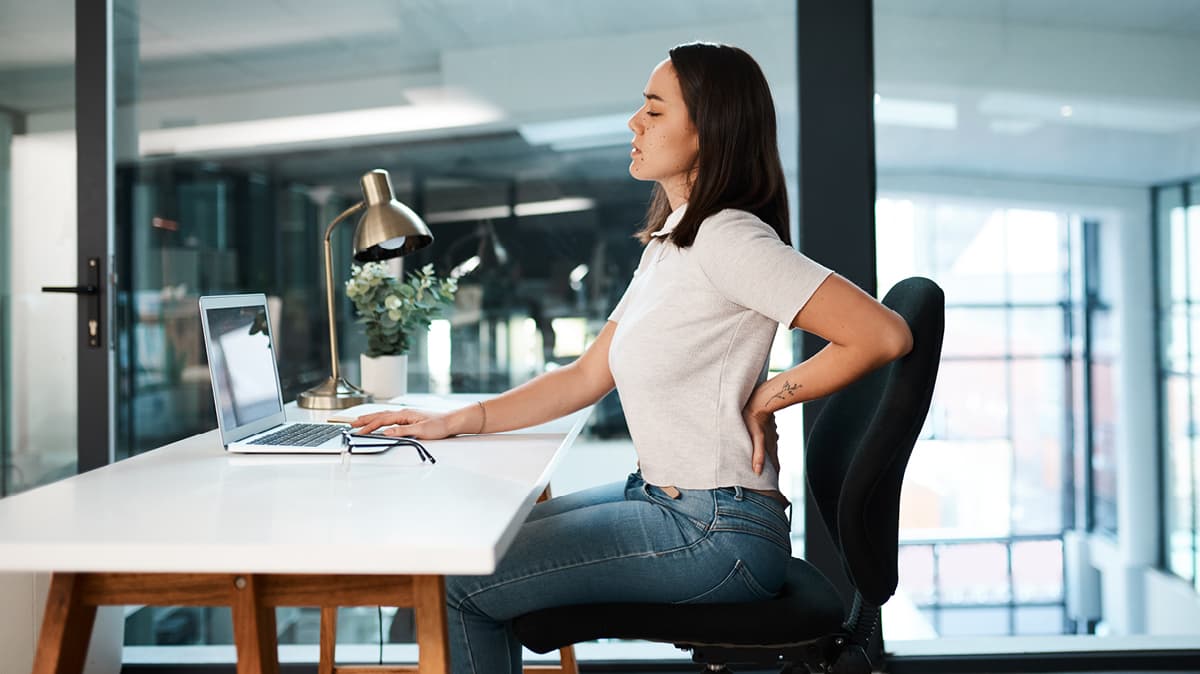How to Improve Posture at Home and in the Office
Working from home without the proper home office ergonomics can impact our health. Follow our expert guide to improve your posture at home and at the office, too.

After many months of working from home at your not-so-ergonomically-friendly kitchen table, or after years of slouching at your office desk, now might be the time to think about how to improve your posture.
But why is posture so important? While hunching over your desk might seem harmless, in the long term it can cause fatigue, recurring pain and also play havoc with your joints. “Posture is important because it determines the level of effort on the muscles that’s required to hold that position,” says Scott Coleman, the founder and CEO of Preventure.
“Postures that require a high level of effort can increase risk of muscle overload and neck or back pain.” So, how do you get started with improving your posture? Read on to find out.
See Also: Home Office Ergonomics: A How To Guide


Flexiworks helps support your team wherever work happens
Learn MoreThe Impact of Working From Home on Posture
When you don’t have the proper home office ergonomics, it can result in bad posture and long-term health issues.
Since the beginning of the pandemic, employees have had to quickly adapt to makeshift workspaces around the house, which often don’t have the proper home office ergonomics. This can result in bad posture and working habits that can impact employees in the long term. “Signs have started to emerge that indicate an increase in the number of injuries treated by chiropractors and physiotherapists,” says Coleman. “This may translate into increases in workers’ compensation claims in the near future.”
The Difference Between ‘Good’ and ‘Bad’ Posture
We’ve all heard of ‘good’ and ‘bad’ posture, but what defines whether posture is actually good or bad? Coleman says this is up for debate. “In theory, an upright alignment of the spine, or the traditional ‘good’ posture, is characterised by the head positioned over the vertebrae of the neck, which enables the weight of the head to be supported with minimal effort from the muscles,” he explains. “However, different people have different strengths and weaknesses, as well as different body shapes. “The goal should not be developing ‘good’ or ‘bad’ posture. Instead, the key is finding the most efficient posture for the individual to reduce the risk of neck or back pain.”
Improve Your Home Office Ergonomics
Improve your home office ergonomics with an ergonomic chair that has a high backrest and lumbar support.
Get started with improving your posture by reassessing your workstation and investing in a proper chair and tools to help you improve your posture habits. “Use an adjustable supportive chair with a high backrest and lumbar support, with the backrest slightly reclined to 10-20 degrees from vertical,” suggests David Carroll, general manager at Bodycare Workplace Solutions. “The chair should support the whole spine, plus adjust your chair height so your elbows are just above the height of your desk.”
Boosting your screen height and distance from your body can also help reduce the load on your neck and back. “Elevate your screen to eye height by placing your laptop on a box, use a wireless keyboard and mouse, and consider a second screen,” advises Carroll. “Make sure your screen is about an arms-length away from you. And, most importantly, change posture every 30 to 45 minutes.”
See Also: Inspiring Home Office Design Ideas
Implement Exercise Into Your Weekly Routine
Along with improving your home office ergonomics, Carroll says physical exercise is particularly important in improving your posture, muscle strength and overall health, now and into the future. “Increasing your daily exercise is the key to living a prolonged life,” says Carroll. “The World Health Organisation recommends that healthy adults should complete at least 150-300 minutes of moderate-intensity aerobic physical activity or at least 75-150 minutes of vigorous-intensity activity throughout the week.”
Carroll also suggests that, along with exercise, workers should also do muscle-strengthening activities that involve all major muscle groups on two or more days a week. “To help reduce the detrimental effects of high levels of sedentary behaviour on health, adults should aim to do more than the recommended level of moderate to vigorous intensity physical activity,” he adds.
Easy Office Exercises To Try
Incorporate stretches and movement into your workday to help improve your posture and avoid stiffness.
Throughout your workday, make sure you take the time to stretch and move your muscles and joints at short intervals to avoid stiffness and slouching. “Try to move more and vary your posture throughout the day,” says Carroll. “I recommend standing or going for a walk around the house while taking phone calls, and try not to spend your breaks sitting at your desk.”
Another great tip? “Remember the ‘curve reversal’ rule,” recommends Carroll. “For example, if you’ve been leaning over your desk, stretch back the other way to boost muscle flexibility, strength and tone.”

